India's Third Giant Leap
This Could be One of the Biggest Opportunities for Investors
- Home
- Views On News
- May 16, 2022 - 6 Popular Stocks that Turned into Penny Stocks
6 Popular Stocks that Turned into Penny Stocks

Editor's Note: Back in November 2021 we wrote on 6 popular stocks that turned into penny stocks. Read this updated article to know where these penny stocks stand now...and if there have been more additions to this list.
Here goes...
A friend of mine recently bought 10,000 shares of Vodafone Idea.
His argument was simple. He was of the view that the government picking a stake in the telco would give the company new wings to fly.
He thinks that the government could merge Vodafone with BSNL which could help both the companies in the 5G era. (Vodafone’s wireless coverage and BSNL’s pan-India wired coverage).
And when this happens, Vodafone Idea shareholders will hit a jackpot.
He knew that the share price of the company can go all the way down to zero. But he was willing to accept the downside risk as the upside potential was also huge.
At first glance, there is nothing wrong with his argument. If everything goes as assumed, my friend "could" indeed walk away with a lot of profit.
But little did he know that all this is easier said than done.
With the sizeable debt that the company is sitting on and its history of reporting losses, Vodafone Idea could just as easily lose market share to Airtel and Jio. (It's losing subscribers since early 2020).
That is why you should always prefer stocks with strong balance sheet and a good track record.
Such stocks manage to ride out the bad phase and earn handsome returns when the market returns to normality.
If you do not get this right...you could indeed be in a stock that could become a penny stock over time. Effectively resulting in potentially huge losses.
Let’s move on to the list of stocks that did become penny stocks...
Investing in stocks by its very nature is a bumpy ride. Stocks never go up in a straight line.
But if the stock is of good quality, it will eventually recover and also end up giving good returns over the long term.
However, if it's not, you may as well be stuck in a value trap.
Investing in fundamentally weak stocks and the ones that have corporate governance issues, doubtful related-party transactions, or heavy debt, can cause unparalleled damage.
In today's article, we look at popular stocks that crashed big time and turned into penny stocks, i.e. which went from 'Multibaggers to Multibeggers'.
#1 Unitech
Talking about wealth destroying stocks, ones belonging to the real estate sector feature on the top of our minds.
And one of them is the market darling of 2007 - Unitech.
Unitech was India's largest listed real estate company in 2007. During the 2003-08 real estate boom, Unitech was one of its poster boys. Its promoters - the Chandras were the second wealthiest developers in India after Kushal Pal Singh of DLF.
In the mid-2000s, as the real estate sector was at its peak, many developers expanded their operation to other parts of the country. Unitech was one of them.
In 2007-2008, Unitech Wireless, a subsidiary of Unitech, applied and won the 2G telecom license by paying the government Rs 16.6 bn under the infamous first-come, first-serve policy. Later that year, Unitech sold 67.25% of Unitech Wireless to Telenor of Norway for Rs 61.2 bn.
As the stake sale happened when the company had no other asset on its books, it was assumed that this was the value of the license it held. Then the scam went bust.
A CAG report blew the lid off, saying the sale of inexpensive spectrum caused the government a loss of up to Rs 1.76 lakh crore, while benefiting private corporations like Unitech.
Then came the financial crisis of 2008 following the collapse of Lehman Brothers. The red hot Indian real estate market went bust.
By 2009, Unitech had bought 14,000 acres of land across India and to bankroll these purchases, it had planned to raise US$1.5 bn by listing some assets in a real estate investment trust (REIT) in Singapore and another US$1 bn from investors.
But before the company could raise funds, financial markets fell and all of Unitech's plans to raise funds got shelved. It ended up with debt of over Rs 80 bn.
Shares of Unitech went on a free fall. Its marketcap fell from Rs 873 bn to Rs 37.5 bn in just a matter of 10 months. That's a wealth erosion of 96%!
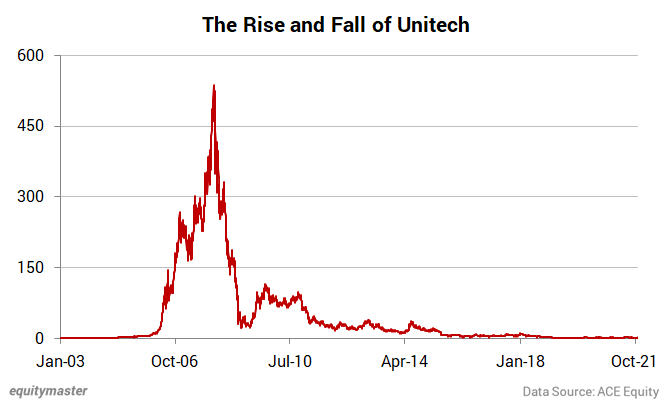
Unitech's current marketcap stands at Rs 6 bn.
#2 Vodafone Idea
Telecom companies are straddled with high debt, intense competition, and lack of pricing power.
High spectrum costs and regulatory issues have hampered the sector. And Vodafone Idea has suffered the most from it.
Troubles for Vodafone Idea started with a retrospective tax when Vodafone PLC purchased a 67% share in Hutchison Essar for US$11.1 bn and the Indian tax department asked the operator to pay Rs 200 bn as penalty.
Vodafone Idea was once a giant that ruled the telecom industry but went extinct when a new baby was born in this country.
India's richest man Mukesh Ambani's telecom baby, Reliance Jio, was born in September 2016.
With the launch of Jio, India's telecom story was re-written. Big operators - Bharti Airtel, Vodafone India, and Idea Cellular were caught by surprise.
At that time, Vodafone used to get close to 90% of revenues from calling. Reliance Jio's free voice calling made matters worse. Later on, Jio announced its cheap tariff plans.
Apart from bringing cheap data plans, Jio launched the Jio Phone and the Jio Phone 2 at very affordable prices, whereas Vodafone had no such option.
Even after merging with Idea in 2018, the telco has not been able to recover.
Then came the Supreme Court's AGR verdict in favor of the government in 2019 which asked the already beleaguered company to pay or to clear all dues related to average gross revenue. This year though, the court allowed operators to make payments in 10 years.
In April 2015, Vodafone Idea had a marketcap of Rs 729.2 bn, which fell to a low of Rs 84.8 bn in November 2019.
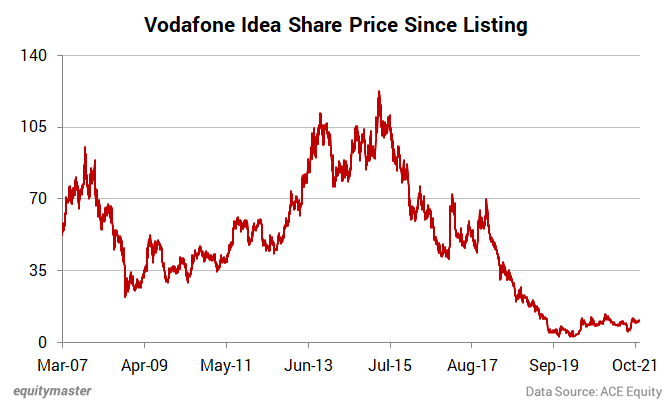
Update: Shares of Vodafone Idea currently trade at Rs 10 with a marketcap of Rs 322 bn.
As things stand now, Vodafone Idea is desperately looking to bounce back. It's looking to raise funds and add more firepower to its arsenal.
The debt ridden telco last month approved raising up to Rs 145 bn out of which 45 bn will be raise from promoter group entities.

It remains to be seen how the company gears up when 5G services are rolled out.
#3 Suzlon Energy
This article might have reopened some old wounds for those people who bought Suzlon at its peak in 2008.
In 2008, Suzlon Energy share price was at its peak at Rs 459. But today, it's a penny stock with a price as low as Rs 11.
Till 2007-08, Suzlon was a healthy company. It posted a consolidated net profit of Rs 10.2 bn in fiscal 2008 on a turnover of Rs 136.8 bn.
As Suzlon's Indian business was doing well, it made big-ticket global acquisitions. In 2006, it acquired Belgian wind turbine gearbox manufacturing firm, Hansen Transmissions International NV.
In 2007, it bought a majority stake in the German wind turbine maker REPower. Between 2007 and 2011, Suzlon progressively ramped up its stake in Senvion and eventually bought out the whole company.
But little did we know that the company's promoters started to ignore Indian markets in order to acquire global ones.
Then came the downfall in 2008, when Lehman Brothers collapsed. Order flow from two of the biggest energy markets of the world Europe and the US stopped completely. Losses and debt both started to rise.
In the five years between fiscal 2010 and fiscal 2015, Suzlon's losses widened nearly ten times to Rs 91.6 bn.
From having a marketcap of Rs 680.7 bn in January 2008, Suzlon's marketcap stood at Rs 55.3 bn in December 2008...a wealth destruction of over 90% in a span of 11 months.
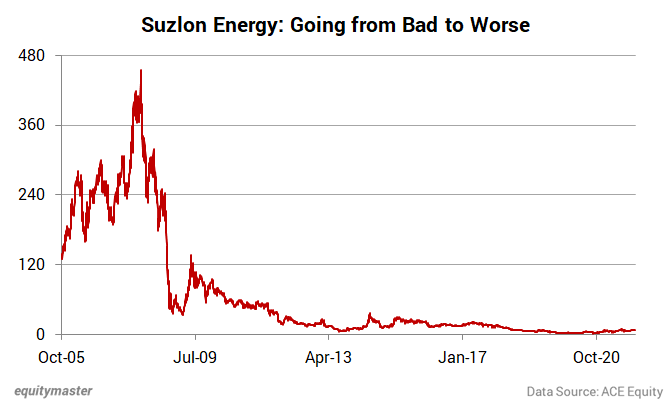
Update: Suzlon currently trades at Rs 11 with a marketcap of Rs 101.5 bn.
The September-December 2021 quarter turned out to be a good one for the company when it was back to posting profits on account of higher revenues.
Suzlon is now looking to raise funds to the tune of Rs 30 bn for refinancing term-loans. For reducing debt, Suzlon's lenders have approved a plan to convert part of its debt into equity that would see Suzlon's promoter Tulsi Tanti's stake fall to 12.7% from 16%.
#4 BHEL
Wondering how a good stock like BHEL ended on this list?
BHEL was a very popular stock in the 2003-2008 bull run. It delivered 10x gains during this phase.
But the aftermath of 2008 financial crisis left a hole to fill for country's largest power equipment maker. After 2008, BHEL was hit by a string of order cancellations and earnings downgrade.
Back then, new orders were difficult to come because high interest rates affected the investment cycle.
In terms of wealth destruction, BHEL's marketcap peaked at Rs 1,406.8 bn back in November 2007. Its current marketcap is Rs 218.5 bn.
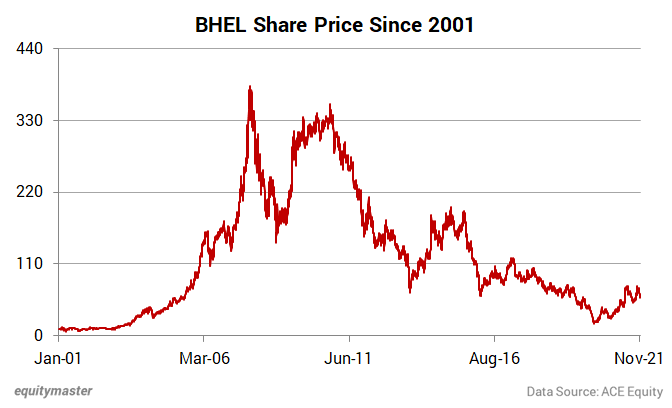
Update: In the December 2021 quarter, BHEL reported quarterly profits after at least 7 consecutive quarters of losses.
The power sector, which was underperforming for many years, seems to have woken up and even boring stocks from the sector are trending higher.
Neither power generators nor power distributors nor the utilities have been money spinners for shareholders. But the way Adani Power and Tata Power have rallied in the past few months surely gives hope to BHEL investors.
#5 Reliance Communication
Before Reliance Jio came into play, Reliance Communications (RCom) disrupted the telecom sector.
When other operators charged anywhere between Rs 4-6 per minute even for incoming calls, RCom offered them for free with a Rs 500 handset.
RCom even hired former Indian cricketer Virender Sehwag with a catchy 'Karlo duniya mutthi mein' jingle.
However, the company's choice of technology in CDMA early on, made it invest capital into expanding into 3G and GSM services. That's when the troubles started.
RCom discovered CDMA services generated less revenue than GSM. So it invested heavily to roll out GSM services and eventually ended up with massive debt.
Anil Ambani grabbed users through an aggressive pricing strategy which was 60% cheaper than rivals.
But over the years, debt ballooned and RCom was unable to reduce the debt due to failed business sales and falling revenues.
Reliance Jio's entry was another trigger which lead to RCom drawing down curtains on 2G and 3G services.
In 2012, RCom lost the second position to Vodafone, moved further down to the fourth spot in 2016, and ultimately lost its grip on the market.
RCom tried to find solutions, one of which was a proposed merger with Aircel, but the deal fell through.
RCom's marketcap peaked at Rs 1,693.2 bn when its share touched a high of Rs 821 in January 2008. In the next 13 months, the share price fell to around 150 and the marketcap touched a low of Rs 273 bn.
The wealth destruction did not stop there. Matters went from bad to worse. Till date, the company has not recovered. RCom's current marketcap stands at a mere Rs 8 bn.
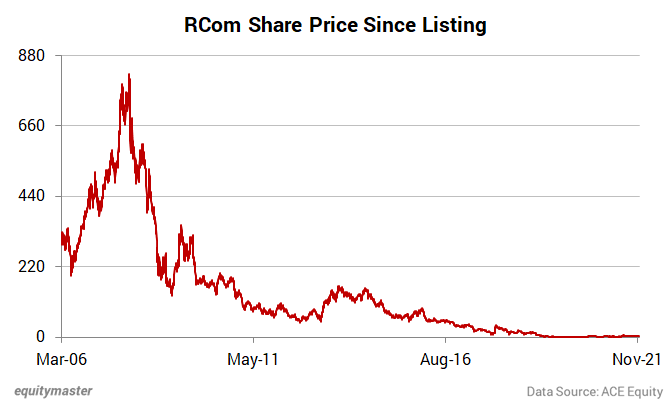
#6 Vakrangee
Back in January 2018, a little-known stock was grabbing all the headlines. It was in the news for having crossed Rs 500 bn in marketcap.
The tiny software company's marketcap was higher than companies with almost 4 to 5 times its sales and profits.
It has surpassed the marketcap of the pharma heavyweight Lupin (marketcap of around Rs 424 bn) - a much bigger company with sales and net profits more than 4 times that of Vakrangee.
Investors in Vakrangee were rubbing their hands in glee. After all, the stock had turned into a 10 bagger in just two years.
Back then, Vakrangee was the largest enrollment agency for UIDAI and carried out over 50 m Aadhaar enrolments.
It came under the lens of markets regulator for alleged price and volume manipulation of its own scrip at Bombay Stock Exchange (BSE) and the National Stock Exchange (NSE).
Reportedly, a group of 22 clients related to each other as well as to the company were continuously buying and selling the scrip, accounting for 74.87% of market gross on certain days.
Following this news, shares of the company went on a free fall and fell even more after a few months.
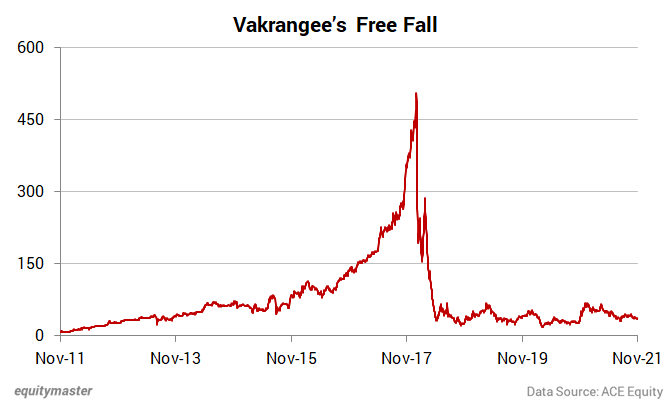
In May that year, Price Waterhouse & Co., its auditor, resigned abruptly, stating that while it repeatedly sought information on matters related to 'election books, bullion and jewellery businesses' of the company, it failed to get any relevant information.
From having a marketcap of Rs 535 bn, Vakrangee eroded investors' wealth amounting to more than Rs 500 bn within a matter of months.
Update: Vakrangee's current marketcap stands at Rs 37.5 bn.
In recent months, the company has tied up with broking firms including Upstox, Choice Broking, and Angel Broking to offer online trading services.
Meanwhile, the Reserve Bank of India (RBI) in March 2022 provided authorization to Vakrangee for setting up, owning, and operating white label ATMs (WLA) in India.
The takeaway
So these were among the many stocks that fooled investors. Most of them were once big, well-known companies.
When these stocks started to fall and touch new lows, investors got interested, hoping they will make a comeback. On the contrary, they fell even more, destroying more wealth.
These kinds of stocks are often categorised as value traps...they appear to offer value, but in reality, they are traps.
They have certain red flags such as loan defaults, rating downgrades, selling of pledged shares, rising debt, and poor earnings.
You must learn to differentiate opportunities from traps and to do so, the first thing you should keep in mind is that beaten down stocks do not justify buying that stock. A consistent fall can actually be a sign of something grim.
As its said, investing is simple but not easy. Stock selection is tricky but with the right fundamental analysis and margin of safety, one can make it big.
Luckily, Equitymaster has a checklist which saves you from toxic stocks.
This checklist is a great tool, especially in current times where a lot of cockroaches are being discovered from the financial kitchens of small and mid-sized companies.
- 8 Figure Fortune Masterclass: Find the Best Stocks of the Decade With My Proven AAA Checklist
- My 4-Point Checklist to Avoid Stocks Like Jet Airways
- Your Correction Checklist... and What to Make of the Crypto Carnage
- Is this the best way to avoid toxic stocks?
- A checklist to manage risk
- The 5-Point Checklist to Save You from Toxic Stocks
- Is Indiabulls Housing the Next Yes Bank?
Also check out the below video where Co-head of Research at Equitymaster Rahul Shah discusses stocks to avoid in 2022.
List of top stocks to buy in 2022 are dime a dozen. But have you ever created an anti-list i.e. stocks to avoid in 2022?
On what basis should you select these stocks and how many stocks should the list contain?
Rahul answers all these questions in the below video.
Disclaimer: This article is for information purposes only. It is not a stock recommendation and should not be treated as such. Learn more about our recommendation services here...

Yash Vora is a financial writer with the Microcap Millionaires team at Equitymaster. He has followed the stock markets right from his early college days. So, Yash has a keen eye for the big market movers. His clear and crisp writeups offer sharp insights on market moving stocks, fund flows, economic data and IPOs. When not looking at stocks, Yash loves a game of table tennis or chess.


Equitymaster requests your view! Post a comment on "6 Popular Stocks that Turned into Penny Stocks". Click here!
Comments are moderated by Equitymaster, in accordance with the Terms of Use, and may not appear
on this article until they have been reviewed and deemed appropriate for posting.
In the meantime, you may want to share this article with your friends!